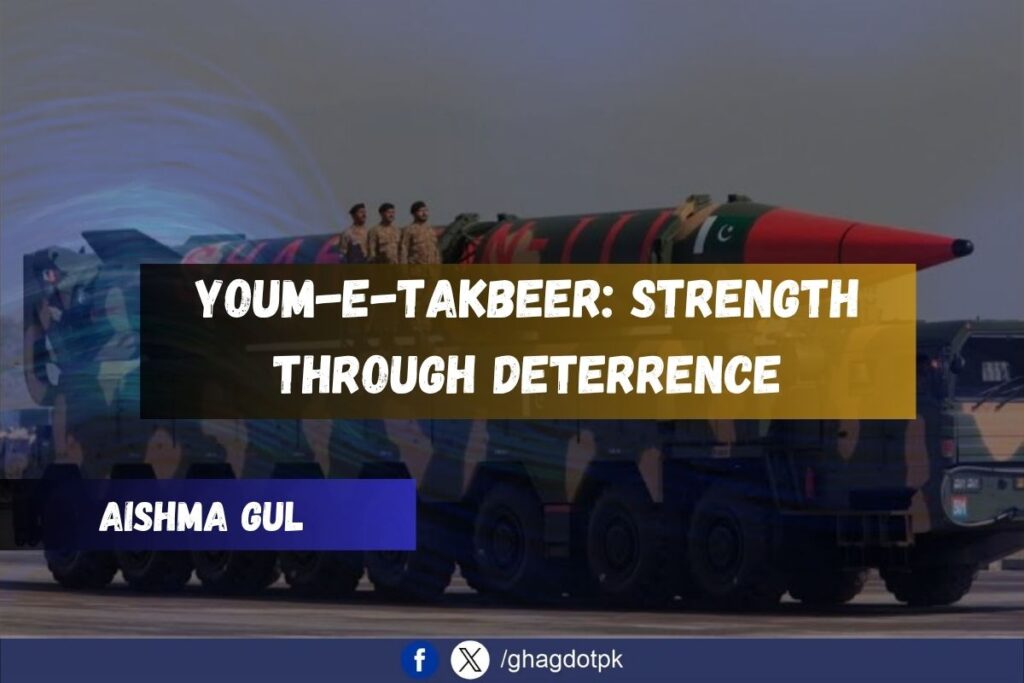By Aishma Gul
“He who defends his home with foresight need never taste the bitterness of defeat.”
This 28 May feels even more significant in 2025 because, just weeks before, Pakistan’s security forces worked hand in hand on 10 May to carry out precise strikes. Army and air units took out several militant launch spots and command centres, used new guided weapons with pinpoint accuracy, and managed the mission without harming civilians. Their quick, professional response showed Pakistan’s unity and strengthened its deterrent stance.
Historical Context and Significance
On 28 May 1998, Pakistan carried out underground tests in the Chaghi hills of Balochistan and became a nuclear power. India had just tested on 11 and 13 May, so Pakistan moved quickly to keep the balance. That day, called Youm-e-Takbeer or “Day of Greatness,” marked a huge leap in science and defence. The cry of “Allahu Akbar” echoed a fresh start in self-reliant security.
By striking back almost immediately, Pakistan made one thing clear: the region’s balance couldn’t be ignored. That swift response lifted spirits at home and forced everyone to see the new reality.
28 May is a public holiday. It brings people together to remember both the science and the strategy behind that moment.
Technical Feats and Scientific Endeavors
Making Chaghi-I happen took detailed planning. The Ras Koh area was perfect—far from towns, stable ground, and able to seal in any radiation. Leaders like Dr. Qadeer Khan and Dr. Ishfaq Ahmed teamed up with the Army to handle every detail. At 3:16 AM, a six-step firing process set off Pakistan’s first test. It was a clear sign of both scientific skill and careful execution.
Strategic Imperative: Nuclear Parity and Deterrence
India’s army was stronger on land, and its “Cold Start” plan showed how serious it could be. Pakistan answered by building its deterrent: a modest yet credible nuclear force, plus a new way to fight normal battles. Adding shorter-range nukes to its lineup sent a strong warning—any attack would be too costly.
Having several layers—big nuclear weapons, small tactical ones, and regular forces—meant any enemy had to think twice. It raised the price of aggression and helped keep the peace.
Recent Indo-Pak Crisis and the Role of Nuclear Deterrence
On 22 April 2025, when gunmen killed 26 tourists in Pahalgam, tensions soared. Pakistan’s leaders met right away, condemned the killings, and put the Army on high alert along the borders. At the same time, Pakistan’s foreign office reached out to the UN, the US, and China, reminding them that any large-scale move would hit Pakistan’s nuclear “red line.” That mix of force readiness and diplomacy kept the crisis from exploding into war.
Commemoration and National Unity
Youm-e-Takbeer is more than a ceremony. It’s a moment to show how science, unity, and defence work hand in hand. Schools and offices hold talks. The military puts on missile displays—Shaheen III and Babur III often headline. Speeches steer clear of bravado; they focus on skill and duty. It’s also a day to salute the scientists and soldiers whose efforts made all this possible.
The name itself came from Choudhry Muhammad Yaqub Arain of Jalalpur Bhattian. His idea was adopted by the federal and Punjab governments, and he was honoured by the state before he passed away in 2015.
In remembering Youm-e-Takbeer, Pakistan shows that real strength comes from clear thinking, solid planning, and firm resolve—qualities that in May 2025 stopped a bigger war and kept peace in place under the shield of nuclear deterrence.






